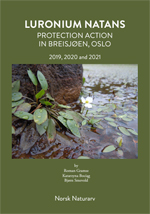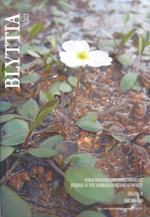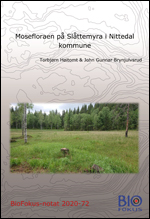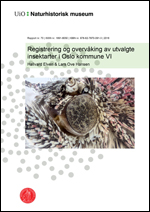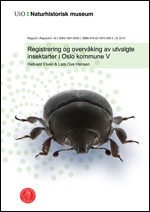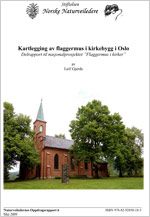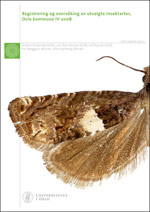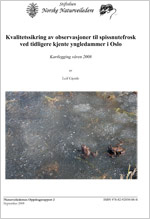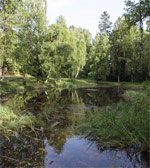11. Referanser

Drakehode. Photo: Torbjørn Røberg.
Dracocephalum ruyschiana L. belongs to the family Lamiaceae.
Dracocephalum ruyschiana L.
Vulnerable.
The species is found from the Oslofjord to Gudbrandsdalen. Norway has the main population in north-western Europe. Eastern and Central Europe and western and central Asia, extending locally westwards to Norway and the Pyrenees.
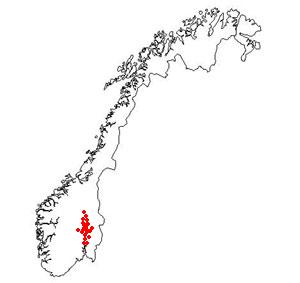
No known exact information but the number is probably 30-100. Red spots indicate known places.
About care: Do not clear completely sparsely growing bushes. It is natural for the species to be partly shaded. Partly shaded places give the plant chance to stay in better condition during very hot and dry summers. It is advisable to monitor protection activity.
Now 15 known.
Location: Bleikøya 1.1.
Individuals: Ca 80 +10.
Area: 10 x 20 m (or 10 x 40m with a small distant cluster).
Environment (habitat): Open top of a ridge and a slope facing South. With other species: Geranium sanguineum, Filipendula vulgaris, Telephium maximum, Sedum spurium, Cotoneaster sp., Rosa sp. .
Condition: Probably after a very hot and dry period in May the plants are very small and almost without flowers. Stems up to ca 20 cm. Maybe bird nesting influence this site..
Care: Began 2005.
GPS-koordinates: 0547502 66400403 - 0547531 66400435.
Date of watch: 19.06.2005. 6.6.2007, 3.6.2008 and 21.6.2008.
Owner: Statsbygg.
Photos: 1639, 1640 (R. Gramsz).
Observer: R. Gramsz, J. Potocka.
Location: Bleikøya 1.2
Individuals: Ca 320.
Area: 30 x 10 m + 3 x 4 m (potential area 40 x 40 m).
Environment (habitat): Open top of a hill and a slope facing NWN and lower terrace on the E of top. With other species: Geranium sanguineum, Filipendula vulgaris, Telephium maximum, Thymus sp, Fragaria vesca, Polygonatum odoratum, Rosa sp., Cotoneaster sp.
Condition: Probably after a very hot and dry period in May the plants are very small and almost without flowers. Stems up to ca 20 cm.
Care: Do not clear completely sparsely growing bushes. It is natural for the species to be partly shaded. Partly shaded places give the plant a chance to stay in better condition during very hot and dry summers. Clearing is not necessary at this site now.
GPS-koordinates: 0547530 66400443. (UTM - WGS84).
Date of watch: 21.06.2008 and 26 06 2008.
Owner: Statsbygg.
Photos: 1658, 1659 (R. Gramsz).
Observer: R. Gramsz, J. Potocka.
Location: Bleikøya 1.3
Individuals: Ca 10.
Area: 5 x 5m.
Environment (habitat):
Condition:
Care:
GPS-koordinates: 0547408 66400459. (UTM - WGS84). Under a footpath on the northern side of a place for boat storage in winter.
Date of watch: 18.6.2006, 6.6.2007 og 3.6.2008 and 21.06.2008.
Owner: Statsbygg.
Photos: No.
Observer: R. Gramsz, J. Potocka.
Location: Bleikøya 1.4
Individuals: Ca 90.
Area: 100 (120) x 50m.
Environment (habitat): A slope facing NW mostly overgrown by high bushes and trees (covering ca 60%). Dracocephalum grows rather sparsely both in the open area and under the bushes. Also open area in winter boat storage place. Bushes and low trees: Cotoneaster sp., Rosa sp., Juniperus communis, Crataegus sp., Pinus sylvestris (several), Syringa vulgaris (several); herbs: Geranium sanguineum, Polygonatum odoratum sp., Filipendula vulgaris, Thymus pulegioides, Arctostaphylos, Fragaria (vesca?), Hepatica nobilis, Convallaria majalis.
Condition: Plants are in relatively good condition (some flowering) comparing with those growing in open area.
Care: Light clearing up to 20% desirable, especially in the places where the plants still exists in the strong shade.
GPS-koordinates:
Date of watch: 21.06.2008.
Owner: Statsbygg.
Photos: 1637; 1638; 1645 (R. Gramsz).
Observer: R. Gramsz, J. Potocka.
Location: Bleikøya 1.5
Individuals: Ca 50.
Area: 10 x 25 m.
Environment (habitat): Open ridge and a slope sparsely overgrown by bushes. With other species: Geranium sanguineum, Filipendula vulgaris, Telephium maximum, Origanum (vulgare?), Cotoneaster (divaricatus? lucidus?), Prunus spinosa, Rhamnus cathartica, Sedum spurium
Condition: Probably after a very hot and dry period in May the plants are very small and almost without flowers. Stems up to ca 20 cm.
Care: Light clearing up to 20% desirable, especially in the places where the plants still exists in strong shade or to extend the potential area a little.
GPS-koordinates: 0547193 66400286. (UTM - WGS84). Top of the hill with the war monument (krigsmine?) and S and SE slope.
Date of watch: 19.06.2005. 18.6.2006, 6.6.2007 og 3.6.2008 and 17.06.2008.
Owner: Statsbygg.
Photos: 1609, 1610 (R. Gramsz).
Observer: R. Gramsz, J. Potocka.
Bleikøya 1.6 A
Individuals: Ca 100.
Area: 5 x 15 m.
Environment (habitat): On the open slope facing south, on shallow stony soil.
Condition: Probably after a very hot and dry period in May the plants are very small and almost without flowers. Stems up to 20 cm.
Care:
GPS-koordinates:
Date of watch: 17.06.2008.
Owner: Statsbygg.
Photos: 1606, 1607 (R. Gramsz).
Observer: R. Gramsz, J. Potocka.
Location: Bleikøya 1.6 B
Individuals: 3.
Area: 1 m2.
Environment (habitat): On the edge of the bushes.
Condition: Plants are quite big, but without flowers.
Care:
GPS-koordinates: 0547346 66400441. (UTM - WGS84). Under the cottage (blue), towards the sea, ca 30 m S from location 6.
Date of watch: 3.6.2008 and 17.06.2008.
Owner: Statsbygg.
Photos: 1602 (R. Gramsz).
Observer: R. Gramsz, J. Potocka.
Location: Bleikøya 1.7
Individuals: Ca 50.
Area: 5 x 10 m (the main area, ca 30); and 20 x 20 m ca 20 sparsely among small bushes.
Environment (habitat): On the open ridge and slope facing south , on shallow stony soil
Condition: Probably after a very hot and dry period in May the plants are very small and almost without flowers. Stems up to ca 20 cm.
Care: Light clearing up to 20% desirable, in the part of this site which is closest to the house (NE part of the area).
GPS-koordinates: 0547085 66400224. (UTM - WGS84).
Date of watch: 3.6.2008 and 17.06.2008.
Owner: Statsbygg.
Photos: 1603, 1604 (R. Gramsz).
Observer: R. Gramsz, J. Potocka.
Location: Bleikøya 1.8
Individuals: ca 50 (30 + 20).
Area: 3 x 5 m + 2 x 4 m.
Environment (habitat): In a line of bushes aside foot path 2 places.
Condition: Plants are in relatively good condition (some flowering) comparing with those growing in the open area. Probably after a very hot and dry period in May the plants (in the open area) are very small and almost without flowers.
Care: Some small clearing could be done to extend the existing site.
GPS-koordinates: 0547021 66400200. (UTM - WGS84). Between houses no. 40 and 42, and the toilet.
Date of watch: 19.06.2005. 18.6.2006, 6.6.2007, 3.6.2008 and 21.06.2008.
Owner: Statsbygg.
Photos: 1635,1636.
Observer: R. Gramsz, J. Potocka.
Location: Heggholmen 2.1
Individuals: Ca 120.
Area: 5 x 10m.
Environment (habitat): SW part of the flat top of the hill. In thermophilous vegetation on shallow soil. With: Geranium sanguineum, Thymus pulegioides, Filipendula vulgaris, Fragaria vesca, Cotoneaster sp., Alium vineale and Vincetoxicum rossicum.
Condition: Probably after a very hot and dry period in May, the plants are very small and almost without flowers (5% blooming).
Care:
GPS-koordinates: SW part of Heggholmen, flat top of the hill.
Date of watch: 24.06.2008.
Owner: Statsbygg.
Photos: 1649 (R. Gramsz).
Observer: R. Gramsz, J. Potocka.
Location: Lindøya 3.
Location: Nakholmen 4.1
Individuals: Ca 120.
Area: 100 x 10 m.
Environment (habitat): The ridge of a hill partly overgrown by bushes (covering ca 50% of the area). In thermophilous vegetation on shallow soil, with Geranium sanguineum, Rosa sp. Cotoneaster sp., Berberis vulgaris, Sedum spurium, Filipendula vulgaris.
Condition: There are some concentrations of individuals (higher, more vivid) growing close to or among the bushes. The rest, in an open area, probably after a very hot and dry period in May are very small and almost without flowers (5% blooming).
Care: Light clearing up to 20% desirable, especially in the places where the plants still exists in the strong shadow.
GPS-koordinates: Stony hill in the central part of W side of the island.
Date of watch: 20.06.2008.
Owner: Statsbygg.
Photos: 1621 1623 (R. Gramsz).
Observer: R. Gramsz, J. Potocka.
Location: Nakholmen 4.2
Individuals: Ca 30.
Area: 10 x 10 m (potential area 20 x 50 m).
Environment (habitat): Open NW slope of a small hill. In thermophilous vegetation with Geranium sanguineum on shallow soil.: Geranium sanguineum, Filipendula vulgaris, Telephium maximum, Cotoneaster sp. (cult. - lucidus? scandinavicus? ), Sedum spurius, Arctostaphylos uva-ursi, Festuca (ovina agg.?).
Condition: Sparsely. Probably after a very hot and dry period in May, the plants are very small and almost without flowers (5% blooming). Stems up to ca 20 cm.
Care:
GPS-koordinates: Open NW slope of a small hill, close to the shore, 100 m S from the harbour, over the compost deposit.
Date of watch: .06.2008.
Owner: Statsbygg.
Photos: 1618 1620 (R. Gramsz).
Observer: R. Gramsz, J. Potocka.
Location: Nakholmen 4.3
Individuals: Ca 60.
Area: 60 x 80 m.
Environment (habitat): The ridge and slopes of a hill partly overgrown by bushes. In thermophilous vegetation with Geranium sanguineum on shallow soil. With: Geranium sanguineum, Rosa sp., Cotoneaster sp., Filipendula vulgaris, Sedum spurius and Berberis vulgaris.
Condition: Sparsely. Probably after a very hot and dry period in May, the plants are very small and almost without flowers (5% blooming).
Care:
GPS-koordinates: Stony hill in the southern peninsula of the W side of the island.
Date of watch: 20.06.2008.
Owner: Statsbygg.
Photos: 1624 1626 (R. Gramsz).
Observer: R. Gramsz, J. Potocka.
Location: Nakholmen 4.4
Individuals: Ca 50 (40 + 10).
Area: 5 x 10m + 5 x 5m (potential area 40 x 50 m).
Environment (habitat): A small hill partly overgrown by bushes (mainly Syringa vulgaris). In thermophilous vegetation on shallow soil. With: Geranium sanguineum, Thymus pulegioides, Filipendula vulgaris, Fragaria vesca, Cotoneaster sp.
Condition: Probably after a very hot and dry period in May, the plants are very small and almost without flowers (5% blooming).
Care: Light clearing of Syringa vulgaris up to 20% desirable.
GPS-koordinates: The main site is located close to the fence of a house no.168 and Syringa bushes and another small one about 15m to the east.
Date of watch: 21.06.2008.
Owner: Statsbygg.
Photos: 1632; 1633; 1634 (R. Gramsz).
Observer: R. Gramsz, J. Potocka.
Lokalitet 5. Ekeberg. Flere til dels individrike forekomster i ekebergskrenten.
Lokalitet 6. Grefsenkollen.
Location: Svartor, Nordmarka 7.1
Individuals: Ca 70 (60 +10).
Area: 8 x 10 m + 5 x 10?
Environment (habitat): On a small dry rocky hill, surrounded by bushes and young trees, and in the neighbouring part of the meadow. With: Juniperus communis, Rosa sp., Leucanthemum vulgare, Hypericum maculatum, Filipendula vulgaris, Trifolium pratense, Trifolium medium, Galium verum, Galium boreale, Vicia cracca, Briza media Convallaria majalis, Polygala Geranium Thymus pulegioides and Fragaria vesca.
Condition: About half flowering. Dracocephalum grows in dense vegetation.
Care: Remove 50% of the trees and bushes from the belt as wide as half of the height of the surrounding trees.
GPS-koordinates: The main site is situated ca 150 m E from Svartor farm on a former footpath to E side of Setertjern.
Date of watch: 19.06.2005, 16. and 28. 06. 2008.
Owner: Private.
Photos: 1598 (R. Gramsz).
Observer: R. Gramsz, J. Potocka.
Location: Svartor, Nordmarka 7.2
Individuals: Ca 30.
Area: 3 x 4 m .
Environment (habitat): On a very small, dry, rocky hill on a side of a meadow. With: Convallaria majalis, Polygala sp., Geranium sanguineum, Thymus pulegioides, Fragaria vesca, Melampyrum sylvaticum and Galium boreale.
Condition:
Care: Light clearing of the surrounding bushes and young trees.
GPS-koordinates: Site is situated just opposite Framstua , on NW side of the road.
Date of watch: 19.06.2005 and 28 06.2008.
Owner: Private.
Photos: 1662 (R. Gramsz)
Observer: R. Gramsz, J. Potocka.
2005 Anslåes å telle 1000-10.000 individer.
Planten er 20-50 cm høy. Vokser sammen i tuer. Stilken er snau. Bladene, 2-5 cm lange, er mattgrønne og linjeformet (spydformete) og sitter i kranser rundt stilken. Blomstene er blå med 20-30 mm lang krone på fiolett beger. Overleppen er hjelmformet og underleppen er trefliket. Fargen er dyp blå, men kan opptre i hvitt og rosa i sjeldne tilfeller. Hver blomst rommer 4-8 mørkegråfrø. Frøene er 3 mm lange og 2 mm brede.
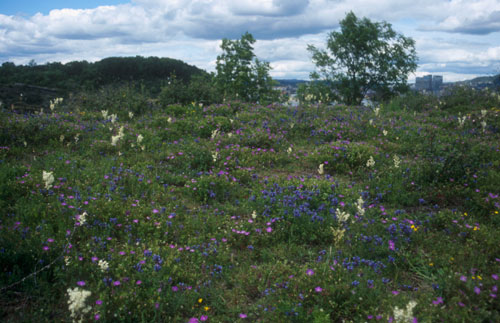
Drakehode trives i lysåpne tørrenger med kalk- og næringsrik jord, og tåler
tørke godt. Planten er varmekjær og står i lavlandet og i lune daler. Står ofte
sammen med knollmjødurt.
Flerårig plante. Blomstringen er fra juli-august. Insekter bestøver blomstene.
Frøene faller ned på bakken rett under frøplanten om høsten og vinteren. Frøene spirer førstkommende sommer. Planten blomstrer året etter spiring.
Drakehode er tilsynelatende en plante med lang historie og stor utbredelse i Norge. Opprinnelig tilknyttet beitemark med ikke for stort beitepress.
Første gang beskrevet av Linné, i 1745.
Arten er i tilbakegang i Norge som i resten av Europa.
I 2004 inngikk drakehode i Norsk Naturarvs overvåkingsprogram.
Det overordnete formålet er å undersøke bestandsutviklingen.
Årlig overvåke lokalitetene i Oslo og Ringerike.
Anslå bestanden i Oslo.
Overvåke lokalitetene i Norge.
Anslå bestanden i Norge.
Ingen kjente.
Kriterier:
Ansvarsart.
Generelt er drakehode i tilbakegang pga. gjengroing, men utbygginger har også vært en negativ faktor.
| År | Kr | Finansiert av |
| 2008 | 5000 | NN |
| 2007 | 5000 | NN |
| 2006 | 5000 | NN |
| 2005 | 5000 | NN |
| 2004 | 3000 | MN og NN |
Norsk Naturarv (NN) og Stiftelsen Miljøansvar (MA).
Naturhistoriska riksmuseet: Den virtuella floran.
Stiftelsen Norsk Naturarv har tatt initiativet og gjennomfører «Overvåkning av drakehode».
Prosjektleder: Torbjørn Røberg.
Registrert av:
2008: Roman Gramsz and Joanna Potocka.
2007: Torbjørn Røberg.
2006: Torbjørn Røberg.
2005: Torbjørn Røberg.
2004: Tore Berg and Torbjørn Røberg.

![]()
![]()
